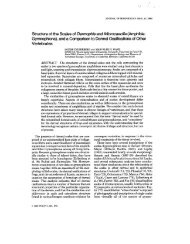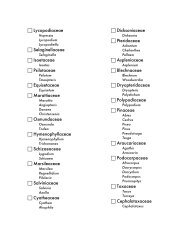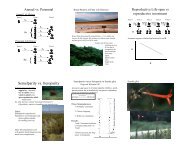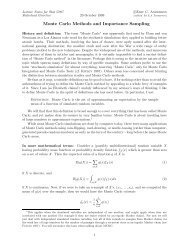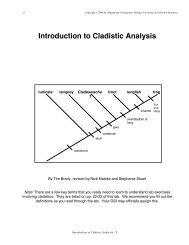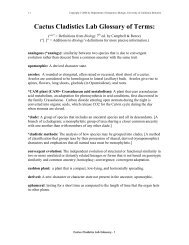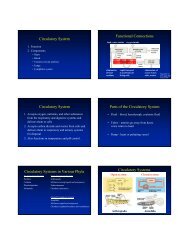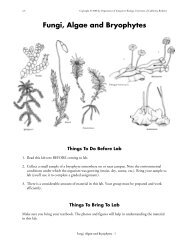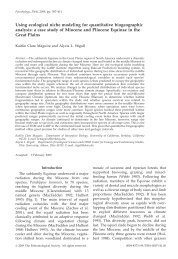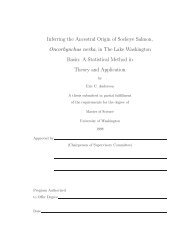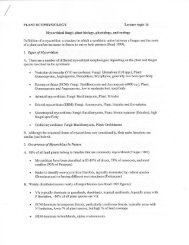Laboratories 4 & 5: Leptosporangiate Ferns
Laboratories 4 & 5: Leptosporangiate Ferns
Laboratories 4 & 5: Leptosporangiate Ferns
Create successful ePaper yourself
Turn your PDF publications into a flip-book with our unique Google optimized e-Paper software.
IB 168 (Plant Systematics)<br />
<strong>Laboratories</strong> 4 & 5: <strong>Leptosporangiate</strong> <strong>Ferns</strong><br />
These two labs cover some of the major families of leptosporangiate ferns (see<br />
Lab #3 for a chart that distinguishes between eusporangiate and leptosporangiate<br />
ferns), sometimes called the “higher ferns” or “true ferns.” This is a group that contains<br />
30-50 families and ~10,000 extant species. After the leptosporangiate fern labs you<br />
should be familiar with the common types of indusia (peltate, reniform, tubular,<br />
laterally attached, false, etc.), the two major categories of spores (trilete and monolete),<br />
annulus types (patch, apical, oblique, vertical, etc.), and other features that help<br />
distinguish the major groups of leptosporangiate ferns. See p. 87-92 in the Simpson text<br />
for more information.<br />
PTERIDOPHYTES: Part II – <strong>Leptosporangiate</strong> <strong>Ferns</strong><br />
Osmundaceae – 3 genera, ~25 spp., temperate and tropical, terrestrial<br />
Homosporous; fertile and sterile fronds present (dimorphic fronds) or<br />
frond divided into sterile and fertile regions; stipules often present at base<br />
of stipe; indusia lacking; no distinct or well-developed annulus; many spores<br />
per sporangium (>128), sporangia spherical; spores green, trilete<br />
Osmunda<br />
Todea<br />
Hymenophyllaceae – 2-34 genera (depending on circumscription), ~600 spp.,<br />
tropical, epiphytic or terrestrial<br />
Homosporous; leaves only one or two cell layers thick; indusia present (cuplike<br />
or tubular); stomata lacking; sori located at the margin of the leaves;<br />
annulus oblique; spores green, trilete<br />
Hymenophyllum<br />
Trichomanes<br />
Schizaeaceae – 4 genera, ~175 spp., tropical, terrestrial, commonly climbing<br />
vines<br />
Homosporous; leaves indeterminate and climbing in Lygodium; dichotomous<br />
branching and venation; sporangia occur singly (i.e. not grouped into sori),<br />
marginal, on stalks at blade tips or on pinnae lobes; indusia absent (except<br />
in Lygodium); annulus apical; spores monolete<br />
Lygodium<br />
Schizaea<br />
Marsileaceae – 3 genera, ~80 spp., tropical and temperate<br />
Heterosporous; sori are enclosed within a sporocarp (microsporangia and<br />
megasporangia within the same sporocarp), which is stalked and arises from<br />
the rhizome or petiole; rooted-aquatic (often with floating leaves) or<br />
terrestrial; spores trilete<br />
Marsilea<br />
Pilularia<br />
1
IB 168 (Plant Systematics)<br />
Salviniaceae – 2 genera, ~13 spp. tropical<br />
Heterosporous; sori are enclosed within a sporocarp (microsporangia and<br />
megasporangia are in different sporocarps); in Salvinia, leaves in whorls of<br />
three, one of the three leaves resembles a submerged "root”; in Azolla, leaves<br />
divided into two lobes, one photosynthetic (with cavities that house the<br />
nitrogen-fixing cyanobacteria Anabaena), the other submersed and nonphotosynthetic;<br />
all are free-floating aquatic, spores trilete<br />
Salvinia<br />
Azolla<br />
• Families below this point have 64 or fewer spores per sporangium<br />
Cyatheaceae – 4 genera, ~650 spp., tropical “Tree <strong>Ferns</strong>”<br />
Homosporous; generally arborescent; numerous scales and sometimes hairs<br />
present at leaf bases; indusia various or lacking, but not as in Dicksoniaceae;<br />
spores trilete<br />
Cyathea<br />
Alsophila<br />
Dicksoniaceae – 6 genera, ~20 spp., tropical “Tree <strong>Ferns</strong>”<br />
Homosporous; arborescent; lacking scales but with hairs at leaf bases;<br />
indusium present, bivalvate, usually half composed by a reflexed portion of<br />
the margin (often colored differently), sometimes cup-shaped; spores trilete<br />
Dicksonia<br />
Pteridaceae – ~40 genera, ~1000 spp., temperate to tropical, also in arid regions<br />
Homosporous; sporangia typically aggregated in lines along the veins or near<br />
the leaf margin; no indusium or a "false" indusium present, formed by<br />
reflexed margin; scales or glandular hairs often present; annulus typically<br />
vertical, interrupted; trilete spores; few spores per sporangium (usu. 32-64);<br />
spores dark in color (i.e. black, brown or gray), not green, trilete<br />
Adiantum<br />
Cheilanthes<br />
Pellaea<br />
Aspleniaceae – ~8 genera, ~700 spp., temperate and tropical<br />
Homosporous; stems typically covered with scales; sporangia located on<br />
veins and are covered by laterally-attached indusia; sori usually linear,<br />
oblique to costa, typically open away from costa; spores monolete<br />
Asplenium<br />
Blechnaceae – ~10 genera, ~300 spp., terrestrial or epipetric<br />
Homosporous; blades often reddish in color when young; sori linear, or<br />
clustered so as to form "chains", parallel to costa; indusia present, opening<br />
inward (i.e. toward the costa); spores monolete<br />
Blechnum<br />
Woodwardia<br />
2
IB 168 (Plant Systematics)<br />
Family<br />
Dryopteridaceae – ~40 genera, ~1500 spp., temperate and tropical<br />
Homosporous; scales present on stems; indusia usually present, reniform<br />
(kidney-shaped) or peltate, sometimes lacking or “acrostichoid” (spread<br />
densely over abaxial surface); sori generally not located along the leaf margin;<br />
leaves often highly dissected, annulus vertical, spores monolete<br />
Dryopteris<br />
Polystichum<br />
Polypodiaceae - homosporous; sori round (sometimes elongate or<br />
acrostichoid) and lacking an indusium; annulus vertical and interrupted;<br />
net-like venation pattern; leaves generally simple or pinnatifid; plants often<br />
epiphytic, annulus vertical; spores monolete, usually yellow<br />
Lecanopteris<br />
Polypodium<br />
Annulus<br />
Indusium<br />
3<br />
Spore<br />
Osmundaceae Patch/Not<br />
Distinct<br />
None Trilete, Green<br />
Hymenophyllaceae Oblique Cup-Shaped or tubular Trilete, Green<br />
Schizaeaceae Apical None (except in Lygodium) Monolete<br />
Marsileaceae N/A – In N/A Trilete,<br />
sporocarp<br />
Heterosporous<br />
Salviniaceae N/A – In N/A Trilete,<br />
sporocarp<br />
Heterosporous<br />
Cyatheaceae Oblique Various (including lacking),<br />
but not as Dicksoniaceae<br />
Trilete<br />
Dicksoniaceae Oblique Bivalvate or cup-shaped Trilete<br />
Pteridaceae Vertical False or none, (some<br />
acrostichoid)<br />
Trilete<br />
Aspleniaceae Vertical Laterally-attached, usually<br />
linear, typically opening<br />
away from costa<br />
Monolete<br />
Blechnaceae Vertical Laterally-attached, linear,<br />
opening towards costa<br />
Monolete<br />
Dryopteridaceae Vertical Reniform or peltate,<br />
occasionally laterally<br />
attached, (rarely lacking)<br />
Monolete<br />
Polypodiaceae Vertical None Monolete
(figure from Palmer. 2003. Hawaii’s <strong>Ferns</strong> & Fern Allies)
(above figure from p.254. Gifford & Foster. 1974. Morphology & Evolution of Vascular Plants. 3ed)
(above figures from p.261-2. Gifford & Foster. 1974. Morphology & Evolution of Vascular Plants. 3ed)<br />
MARSILEACEAE (Marsilea quadrifolia) extrusion of gelatinous cylinder (sorophore) to<br />
which sori are attached<br />
(above figure from p.309. Gifford & Foster. 1974. Morphology & Evolution of Vascular Plants. 3ed)
Glossary: <strong>Leptosporangiate</strong> <strong>Ferns</strong><br />
Definitions from Simpson (2006), Plant Systematics<br />
abaxial: the lower or outer surface of an organ – syn. dorsal<br />
acrostichoid: having sporangia spread densely over the abaxial surface of a lamina<br />
adaxial: the upper or inner surface of an organ – syn. ventral<br />
annulus: a single row of specialized cells, having differentially thickened cell walls, on<br />
the outer rim of a leptosporangium, functioning in its dehiscence<br />
caudex (pl. caudices or caudexes): a short, thick, vertical or branched perennial stem,<br />
underground or at/near ground level – e.g. in Cyatheaceae and Dicksoniaceae<br />
circinate vernation: the manner in which new fern fronds emerge (i.e. from a coiled<br />
fiddlehead)<br />
costa (pl. costae) : midrib<br />
crozier: see fiddlehead<br />
exindusiate: lacking an indusium<br />
false indusium: an extension of the blade margin that overlaps the sorus of a<br />
leptosporangiate fern<br />
fiddlehead: a leaf that is coiled during its development, characteristic of the<br />
leptosporangiate ferns (Polypodiales) and Marattiales – syn. crozier<br />
frond: fern leaf<br />
indusium: a flap of tissue that covers a sorus, found in some leptosporangiate ferns<br />
leptosporangium: the sporangium of the leptosporangiate ferns (Polypodiales),<br />
characterized by developing from a single cell and having a single layer of cells making<br />
up the sporangium wall<br />
paraphysis (pl. paraphyses): a sterile filament or hair borne among sporangia<br />
pinna (pl. pinnae): the first discrete leaflets or blade divisions of a fern frond.<br />
pinnatifid: pinnately lobed to divided<br />
pinnatisect: pinnately divided, almost into discrete leaflets but confluent at the midrib<br />
pinnule: the ultimate divisions or leaflets of a fern frond<br />
receptacle: in ferns, the cushion of tissue bearing the sporangia (often exserted in<br />
Trichomanes)<br />
sorus (pl. sori): a discrete cluster or aggregation of leptosporangia<br />
sporocarp: the generally spherical reproductive structure of aquatic ferns, functioning<br />
in allowing the sporangia inside to remain dormant and resist desiccation for a long time<br />
stipe: a leaf stalk in ferns – syn. petiole



